#ive said this before but i love the paper mario series so luigi’s (and bowser’s) dialogue is mostly inspired from that
Text



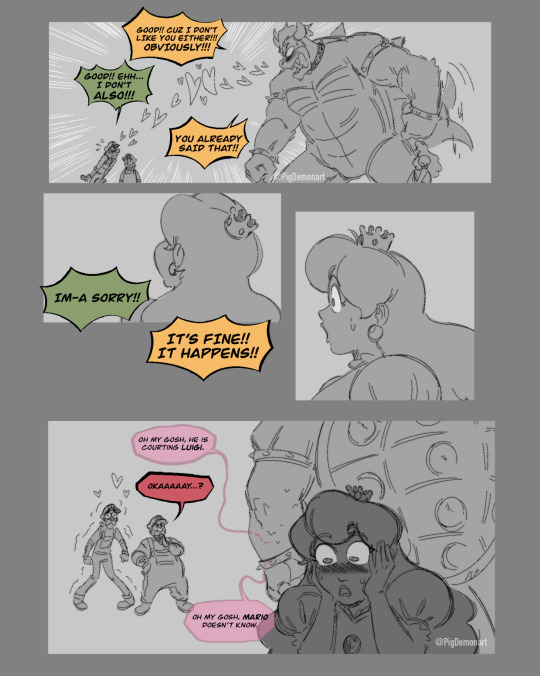
Part 2 of 3
read part 1 here!
Read part 3 here!
This one took a little longer than usual since I’m moving this week, so there is a lot to pack. Fun pages though, every poor expression on Luigi makes me smile. Wet chihuahua of a man.
Like my art? Please consider tipping!
Wanna support? Please check out this zine!
#bowuigi#luigi#bowser#mario#princess peach#super mario#comic#my art#every time i make one of these comics it makes my partner laugh in joy and thats how i know im doin SOMETHING right ufnfnfjfj#anyways noodly luigi in the DOODOO TASTE panel is my fav#and im happy to be drawing mario and peach…#ive said this before but i love the paper mario series so luigi’s (and bowser’s) dialogue is mostly inspired from that#peach too!!! shes very outspoken in super paper mario huhu
12K notes
·
View notes
Text
In celebration of the 30th anniversary of the Fire Emblem series (with the release of the first game of the series, “Fire Emblem: Dark Dragon and Sword of Light released on April 20th, 1990), I will be doing a bit of a low-brow, personal “retrospective” of the games I played from the series. Join me as I talk about my first experience with the series through my first and second favorite Fire Emblem game: “Genealogy of the Holy War”.
[Warning: Foul language, low-brow commentary, and crude remarks on the characters of Fire Emblem. Go watch some boring elitist cornballs with no real talent who think talking about video games on YouTube is a real, viable job on YouTube if you want a serious retrospective on the series]
As with many of my peers who grew up playing video games throughout the 90s, I played such classics from that era such as Super Mario World., Street Fighter II, Sonic, Gran Turismo, Final Fantasy, and Pokemon to name a few. It was thanks to the 1996 capsule monster catching RPG that I would find love within the RPG genre. As my first RPG, I loved the idea of capturing and raising monsters to dominate the world of Pokemon Blue. Later, around the early 2000s, I was introduced to two of my top favorite RPGs of all time: Paper Mario and the original Final Fantasy 3 on the Famicom; which happened to be my first Final Fantasy game.
(For those wondering how and why Final Fantasy 3 was my first FF game: grew up in Nintendo dominate household and my Pentecostal mother thought RPGs were the devil because Christians, especially Black old-school Baby Boomer Christians, live in fear of thinking for themselves and questing religion; so emulation was the way for me.)
I loved the idea of taking a traditional 2D-platformer Mario game and reimagine it as a turned- based RPG spanning across the Mushroom Kingdom as Mario, once again, must save Princess Peach from the clutches of Bowser. As for FF3, the 8-bit charm of four young orphaned youths being the chosen ones of legend to save the world from darkness. While both games’ story could be consider “basic” to some (which, to a degree, they’re sort of right especially on FF3’s front), I enjoyed and loved them.
I would continue my RPG journey as the early 2000s progressed with classics such as Chrono Trigger, Shin Megami Tensei II, Final Fantasy IV, V, VI, and finally VII (mostly 16-bit emulation because, again, scared Pentecostal Christian mother). They told such amazing stories of their worlds. Time travel. Nuclear holocaust. Tales of hope, life, and death. Yet, despite all of that, there was something missing from those games. Something that I could say in confidence would impact me for life.
Don’t get me wrong: it was a shock to see teen pregnancy used as a narrative theme in Final Fantasy VI with realism as Katarin struggles with the fact of becoming a teen mother in an world of ruin. Katarin, along with her lover and baby’s fathers Duane, the oldest member of the destroyed village of Mobliz in the World of Ruin. Chrono Trigger made me thought about my own existence in the universe as I watched Crono and crew ponder about how the universe and its inhibitors became to be during the campfire scene.
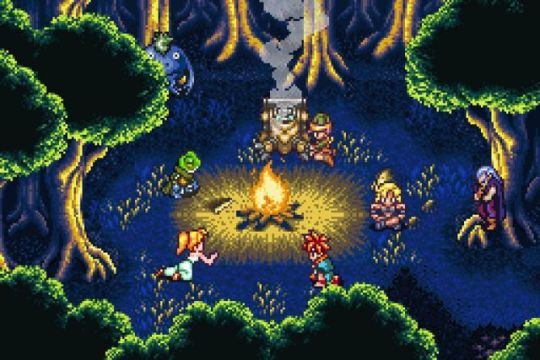
Chrono Trigger campfire scene
Yet – those things didn’t fulfill a certain need of true, down-to-earth realism. I needed something more grounded. Something that would make such sense to me as a young man. Something that I could relate to with absolute:
Super Smash Bros. Melee. for the Nintendo GameCube!
2001:
Through a summer school event, I managed to get my hands on a copy of a Nintendo GameCube demo disc for the PC. Featured on the disc were video demos of upcoming launch titles for the GameCube: including Luigi Mansion, Star Fox Adventures, NBA Courtside 2002, and of course, Super Smash Bros. Melee. Super Smash Bros. 64, the game prior to Melee, felt dwarfed compared to the raw graphical power and scale of Melee. I was aware of and hyped for Melee being created by Nintendo through elementary schoolyard conversations and magazines. Seeing a demo of the preceded flawless game’s action and mass scale drove my desire to get a GameCube and Super Smash Bros. Melee for the 2001 holidays season.
So, did I eventually get Super Smash Bros. Melee for the Nintendo GameCube and the GameCube for Christmas of 2001 like every other good little boy and good little girl?
Of course fucking not! My parents went bankrupt after buying a new house, having to bury my mother’s parents who both died a month apart from each other, and finally — said new house’s kitchen catching on fire; thus, causing us to living in a downtown hotel then a temporary luxury apartment because we all have shit lungs (asthma). I was lucky to get a DVD/VCR combo for Christmas with a few DVDs.
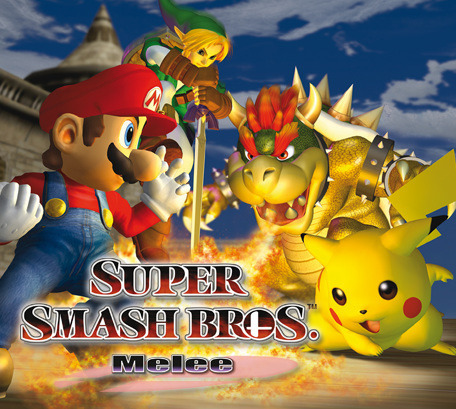
2004:
For three years, I had to live the Melee (and by proxy, the early 2000s gaming) life vicariously. One day, while working on a paper on the history of video games in 8th grade (2004), I discovered the MIDI (Musical Insturmental Digital Interface) video game vgmusic.com. Musically inclined fans could upload their recreation, remixes, and close-to-the-original MIDI files for the nerdy gaming massive to indulge in. Being curious about how the music of Melee sounded, I led myself to the Super Smash Bros. Melee section which had an impressed library of fan made songs from the game.
Scrolling through, there was one track that caught my eye: Hyrule Temple: Fire Emblem. “I don’t remember a Fire Emblem in Majora’s Mask, OOT, nor Zelda II. Maybe I missed something like a secret item named ‘Fire Emblem’ when I had played those games.” I ponder to myself.
Curious, I clicked the link to the song.
Four taps on the artificial hi-hats rang out followed by Latin-like horns, a heavy bassline, and drawn out bass strings and horns building up to the meat of the song.
“Okay, did Link went to Mexico and fight Zorro in a Zelda game because this song sounds super Mexican as hell.”. Rather than do the incredibly smart and not racist thing and Google search Fire Emblem (because I was too busy googling Princess Daisy, Terra Branford , Ayeka Jurai, and Sailor Pluto hentai images and doujins) I just assumed that it was some a weird Zelda thing.
Months later, after my parents recovered from their bankruptcy, they gifted me a Nintendo GameCube for Christmas (they couldn’t find Melee in any store sadly). No worries. I was given a Blockbuster gift card by a family member for Christmas, so I decided to rent Melee the day after Christmas. Wanting to know how to unlock everything, I went online for answers when I came across two Nintendo characters whom which I’ve never heard of: Roy and Marth.
Again, rather than doing the smart thing and Google search “Roy and Marth” (I was googling how to torrent anime illegally this time instead), I decided to play Melee for my answers. After defeating the original 13 fighters, I was alerted with the “Challenger Approach” alarm. A shadowy figured appeared with a male wielding a sword. We’re transported to Kirby’s stage with me wondering who I was going to face off against.
Then, that familiar Mexican sounding melody starts to play.
“Okay, this song sounds ever more Mexican than before now I’m hearing it how it meant to be heard. Why is this white boy speaking Japanese to some Mexican sword fighting music? Is this Zorro’s cousin? Kirby’s friend?”
After defeating Zorro’s half Japanese/Half Mexican cousin from Kirby (I assumed) I’m greeted with the following message:
“Direct from Fire Emblem, it’s Marth, the swordsman supreme!”
“Okay, what’s Fire Emblem, who’s this Marth dude, and why he’s a white boy speaking Japanese to Mexican music?”
Upon unlocking Marth, I ran him through his Classic Mode route to unlock Roy. Fought Roy. Figured out why I thought Fire Emblem was Zelda related after a year (you fight Roy in Hyrule’s Ruins because I guess Roy was sleeping with Zelda behind Link’s back after she slept with Gannondorf). Whoop Roy’s ass and got Marth’s trophy. Wanting to learn more about Marth, I deiced to check out his trophy.
“MARTH
The betrayed prince of the Kingdom of Altea, the blood of the hero Anri flows in Marth’s veins. He was forced into exile when the kingdom of Dolua invaded Altea. Then, wielding his divine Falchion, he led a revolt and defeated the dark dragon Medeus. Afterwards, Altea was annihilated by King Hardin of Akanea.
Fire Emblem
JAPAN ONLY”
“Wait, he saved his kingdom only to have it annihilated by another king? So, a Nintendo hero failed at saving the day for once? That’s interesting.” Reading Marth’s bio deepened my curiosity towards Fire Emblem. “Why was Marth forced into exile? Who betrayed him? How did he escape it? Who’s Medeus and Hardin and how did they manage to destroy his kingdom?”
There was only one way to find out: download Fire Emblem through emulation. But, which one? Visiting my preferred emulation site at the time, Emuparadise, I sought answers through the form of three Fire Emblem games: Mystery of the Crest (FE3), Genealogy of the Holy War (FE4), and Thrica 776 (FE5).
First Try: Mystery of the Emblem

youtube
The game boots up with a shield with five circular groves and a flame crested embedded in the middle while a trumpet and French horn fanfare plays for a few seconds. Next, I’m treated to a tapestry with scrambled text. However, the imagery of men burned alive by dragons, sages praying to the heavens, a god armed with a mighty sword and shield descending to earth from the heavens to slay a dragon, and humans giving praise to their savior to a medieval musical motif told the tale for me.
Following, the intro ends with three strikes of lighting; causing the screen to flash. A known fanfare plays as the words “FIRE EMBLEM: MYSTERY OF THE EMBLEM” fades into the foreground as the Falchion pieces through the text. Finally, I’m introduced to the playable classes and their stats through the game’s attract mode.
Due to the state of the game’s translation, the pre-chapter’s screens were an unreadable mess (a most common issue of Fire Emblem early fan translations days). For all I could had known, this could had been Roy’s game, which I would had been cool with, but I wanted to know Marth’s story.
Skipping past the mess of the “translation”, the game starts.
Axe-men swarming a lone island: pilaving and killing. A young woman on a Pegasus flies away from the carnage to a castle. It is here I’m introduced to Fire Emblem’s first ever characters: Jeigan/Jagan, Ceada/Shiida, and the poster boy of the series: The legendary Prince Mars!
“Yo, who the FUCK is Mars? Where’s Marth?” I asked myself in confusion. I mean, he had blue hair like Marth. Wears a tiara like Marth. Look like a chick like Marth. But, he was clearly Mars. Not Marth. Disappointed (and utterly unaware that Mars is Marth and the translator took the Marusu name too literal), I stopped playing I FE3 and booted up FE4.

But MAAAAAAARRRRRRSSSSS!
Second Try: FE4 (or, my true first Fire Emblem experience)
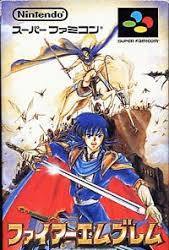
youtube
Immediately, I’m blown away by audio/visual presentation. While the opening text aren’t a jumbled mess unlike the “translation patch” of Mystery of the Emblem, they were in Japanese; a language which (at the time), I lacked understanding of. Regardless, I could understand the story though the art and sound.
Dreadful music plays as the red and black hellfire serves as the background while mighty warriors and fearsome dragons engage each other in brutal combat. Twelve flames, representing the twelve holy gods of Jugdral surrounding a lone tower. As the music reaches a peak and fades out, A dragon of darkness and a dragon of light entangled in a fierce battle and the screen goes black. Silence. Then, a golden wheel fades in with slow strings building up. The wheel is surrounded by glistering weapons in a celestial blue shade before flying off.
Finally, this specular ends with the Japanese Fire Emblem logo proudly appearing as the theme of the series plays in vigorous pride: as if it was an anthem for a militaristic nation.
Even if this wasn’t Marth’s game and even if I lacked the knowledge to understand the Japanese language, the ominous scene displayed for me alongside with the introduction of the actors and players of the world of FE4, I wanted to dive deep into the blood soaked tale of Jugdral.
After the marvelous introduction, I created a new file, got hip to the story of Jugdral thus far, and proceeded to play.
“Finally! That’s Mart- no, who’s the hell is Sigurd and why does he looks like he could be Marth’s older cousin? If that’s Marth’s cousin maybe Marth will show up in this game.” I proceed to play FE4; impressed by the scale of the map compared to FE3’s Book 1 first’s map. FE4’s first map felt like a long-standing war was about to take place while FE3’s first book seemed like a meek, short skirmish. In a way, this set the tone of the overarching theme of FE4’s maps: large armies clashing with one another non-stop.
Needless to say, this was going to be a long, uphill battle –and I was going to love it. By that detail alone at was then that I knew that not only Genealogy of the Holy War was going to be something special for me, but the Fire Emblem series in general.
*****
Three turns passed. The blue hair axe dude, Lex, wasn’t Marth. The other blue hair guy, Finn, wasn’t Marth neither. At this point, I realized two things:
1. I’m racist against blue hair mid-90s anime-inspired fantasy characters.
2. This wasn’t Marth’s game.
In any case, the first few minutes of gameplay impressed me. How should I move my units? Which weapon is best against the enemy’s? Should I keep Arden guarding the castle or should I be bold and reckless by leaving the castle defenseless? Midir wasn’t a girl? Azel have a thing for cute young nuns and so do I.
Hooked, I spent an entire weekend getting through the first three chapters of the game (Birth of the Holy Knight, Maiden of the Spirit Forest¸ and Disturbance in Augstira). By the time I reached Chapter 2, I realized something: I suck. Ethlyn (Sigurd’s sister) got wounded, so these left the game alongside her husband, Quan: causing me to lose two units at once.
I accidently killed Ayra with Alec and my dumbass saved my game after the fact. I also got Jamke killed because Adean, the priestess whom was supposed to talk to him so he could join your cause, was at the other side of the map. I made Azel kill him. But, it didn’t matter. All it matter was that I was having fun with the game and I kept at it.
Why?
Well first, I simply fell in love with the game’s story. Who would had known that Sigurd recusing his friend Aidean from the savages of Verdane was actually a part of a much more diabolical plot orchestrated by the underground cult, The Loptr Church and their leader, Manfory to control the world.
Manfory was the man running the show behind the scenes in an attempt to find the last two surviving decedents of a twisted, dark, demonic dragon god (Lopotsu) in order to revive said dark dragon to plunge the world into disarray, death, destruction, and darkness. Using his pull and promise of power to politicians throughout the land, Manfory was able to install his plan of bringing the world into darkness.
Second, as a teenager, I wasn’t one for politics. It was a topic that bored me to no end. Yet, Genealogy of the Holy War opened my eyes to how brutal and ruthless politics can be. No. Inferior words such as brutal and ruthless are understatements. Cutthroat fits better. I was filled with disgust with Chagall killing his own father, King Imuka, to gain power in Agustria. I took note at how one set of dukes and lords of Agustira bid their time as Sigurd cross blade against the other dukes and lords of their land. Levin’s uncle was willing to kill him and his mother if it meant controlling their nation.
(As Leptor told Sigurd: “Politics is all about power!)
Now, let it be known that politics alone wasn’t the sole reason why I fell in love with Genealogy of the Holy War despite it being the driving force behind why I loved the game. The countless tragedies after tragedies that transpired throughout Sigurd’s tale got me as well. To understand where I’m coming from, let’s go deeper into what I mean by this.
Towards the end of Chapter 1 (Maiden of the Spirit Forest) we’re treated with a touch of “love at first sight” story narrative. Upon conquering Marpha Castle, Sigurd encounters the beautiful and alluring maiden, Deidre, being harassed by a brigand. After running the thug off, Sigurd and Deidre exchange a few words; with Sigurd being shocked that Deidre knows his name (through Aiden) and admitting that he’s everything she imagine him to be. Sigurd ask for her name, which Deidre asks for his pardon for not revealing it before running off loves struck.
Curious about her (and not being able to shake off the feelings of love) , Sigurd asks a local elder about her. The elder informs Sigurd of Deidre’s name, background, and warns Sigurd not to engage in any sort of relationship with Deidre; least disaster shall befall upon the world if she left the forest and found love. Not wanting to believe in such superstitions, Sigurd sets out to find Deidre. They encounter one another and admit that they had fallen for each other…
…And like any good woman and man who fall for each other upon a chance, first meeting, they both fucked later that night. This isn’t me being lowbrow (for once): that scene is in the official Fire Emblem 4 manga written and drawn by Mitsuki Oosawa. Deidre totally fucks on the first date (must be due to of all those years of living a sheltered life).
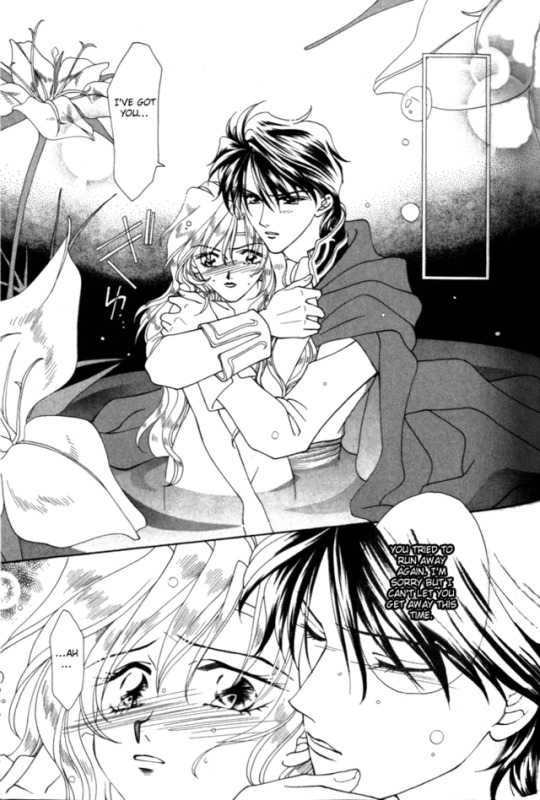
Without context, this scene can be taken completely wrong…
Anyway, after conquering the Kingdom and Verdane, Sigurd and Deidre got married. From their marriage, Sigurd started to change. His sister, Ethlyn, notes how much Sigurd changed thanks to Deidre. He’s no longer a slob. His hot-headed attitude has all but disappeared. He became more upbeat. From their love and marriage came their first and only son, Celice, whom they both loved dearly.
Sigurd was happy.
Deirdre was happy.
And then, Chapter 3 hits – hard.
After receiving news of Sigurd subduing Madino Castle, Deidre decides to leave their army’s home castle to check on her husband. Despite pleas from Shanan (Prince of Issac, his backstory on why he’s in Sigurd’s army is a tad long for this post for me to explain) to ensure that Deidre do not leave the castle as per Sigurd’s request, Deidre leaves; assuring Shanan that she’ll only be but just a second. As Deidre walks outside, she is attacked by Manfory, brainwashed, and taken away by the dastardly villain.
(Keep in mind: Sigurd is prepping to engage in combat against his own best friend, Eldigan)
After subduing Evans Castle, Sigurd is alerted by Shanan that Deidre went missing (in the manga version, Shanan engage in combat against Manfory and fails to rescue Deidre). Sigurd, still stressed out due to discovering the beheaded body of Eldigan in Silvali Castle, sets out to find Deidre.
To worsen matters, Sigurd hears that he and his father Vylon are accused of murdering Prince Kurth of Grannvale (in truth, Vylon’s rivals, Lombard and Leptor, murdered the prince as an attempt to frame Vylon and take Castle Chaply from him).
Sigurd and company are forced to flee to the faraway frigid mountain lands of Silesse. Despite his justified anger/desires to storm Grannvale and expose Lombard and Leptor for their crimes, Sigurd is forced to resolve the civil conflict of Sileese while living as a refugee.
Once the civil conflict in Sileese subsides, Sigurd sets off to Granvale to combat against Leptor and Lombard. He revives his family heirloom, the Holy Tyfring from his father, who has been morality wounded by Lombard’s squad. Sigurd is helpless as his dad dies in his arms and promises to rain wrath and revenge upon Lombard and Reptor for their crimes against the Chaply family and the land of Grannvall. Keeping to his promise, Sigurd successfully slew Lombard and set his sights against Reptor and his unit.
During this time, Quan and his Ethlyn, along with Leonster Lance units, are to aid Sigurd and his army. However, King Tribant (introduced in Chapter 3) ambushes their squad: killing them and leaving behind no survivors sans Cuan and his Ethlyn’s 3 year old child, Altena. Sigurd hears of this news and is devastated by yet another tragic event in his life.
Following, Sigurd eventually take the battle to Leptor, effortlessly defeating him with the help of his army. Sigurd is greeted by Arvis’ aide, Aida, who tells him that Arvis and Kurth’s father knew Sigurd and his father weren’t involved in Prince Kurth’s death. This relives Sigurd, a man who for the past two years dealt with soul-crushing pain. For once, Sigurd is able to take a break and repay his allies for their work.
Yet, all isn’t what they may seem.
While Sigurd and company are welcomed to Belhalla by Arvis in a faux celebration party, Arvis reveals to Sigurd that everything that has transpired within the past three years of Arvis’s doing. He doesn’t pardon neither nor his father for crimes to conspiracy to usurp the Grannvall throne by murdering Prince Kurth. Sigurd is sentence to death. Sigurd, now in absolute disbelief and believing that Arvis is joking, asks if this is a cruel joke, to which Arvis replies that he is not. Before killing Sigurd, Arvis reveals something that Sigurd has been looking for the past year:
Deidre – now recognized as the wife of Arvis.
Arvis insists that Sigurd must be confronted by the daughter of his victim. Deidre, lacking any sort of recollections of her (true) marriage with Sigurd, questions if Sigurd murdered her father. The man snaps, yelling at his wife that he’s married to him, not Arvis, and that he did not do such a horrible thing to his wife who, he loves dearly by killing her father. Deidre is confused. She ponders why Sigurd, the man who supposedly murdered her father, is speaking to her as if he was her familiar. She requests to Arvis that she is given more time to speak with Sigurd to clear things, only to have that requet deny by her new husband.
As Deidre is courted away by Arvis’s royal guards, Arvis believes that Sigurd has said more than enough and orders the execution of Sigurd and his army.
My jaw dropped as I helplessly watched the army whom I raised and the characters I grew to love lives come to a brutal end.
“Nintendo a company for kids and family…Did they just really let one of their main characters die so violently like that?” My teenage mind couldn’t compheren that Nintendo allowed the death of a main character (among many other controversial things) in one of their games.
Continued in Part II.
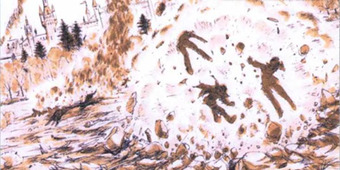
youtube
FOLLOW ME ON SOCIAL MEDIA:
The Swarthy Nerd Podcast
A Black nerd empowerment podcast where Black nerds (well, all nerds, but Black first and foremost) can get together and talk freely about nerd culture while also acknowledging systematic white supremacy and racism in the nerd and Eastern otaku fandoms. Every Tuesday join @superlostfan108 and @weebtrashyuki the founders of http://www.swarthynerd.com for there very informative podcast talking about all things nerdy. No desperate boot licking self hating negus who were never accepted by Black norimes for being too weird for their love of anime and comic books by the Black community allowed. Go drink bleach.
Instagram: YukiTheSnowMan314
My Facebook Page:
Yuki The Snowman
https://www.facebook.com/yukithesnowman/
“Personal’” Facebook:
Yuki Benji
https://www.facebook.com/yuki.benji.1?ref=br_rs
Twitter:
https://twitter.com/weebtrashyuki
Tumblr
YukiTheSnowMan314
https://yukithesnowman314.tumblr.com/
15 years ago, I learned that Sigurd is not Marth's cousin and that I might a racist towards and against any Fire Emblem with Blue Hair (they all look alike to me -- i am not sorry). In celebration of the 30th anniversary of the Fire Emblem series (with the release of the first game of the series, “Fire Emblem: Dark Dragon and Sword of Light released on April 20th, 1990), I will be doing a bit of a low-brow, personal “retrospective” of the games I played from the series.
#arvis did nothing wrong#fe4#Fire Emblem#Fire Emblem 30th#fire emblem 4#Fire Emblem retrospect#genealogy of the holy war#JRPGs#nintendo#RPGs#seisen no keifu#super famicom#Super NES
0 notes